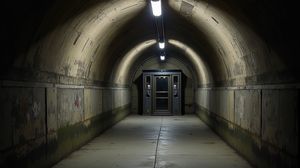
Canary Wharf, one of London's primary financial districts, stands on the Isle of Dogs and is part of the larger Docklands area in East London. It is renowned for its impressive skyline, featuring some of the tallest buildings in the United Kingdom, and serves as a hub for business, banking, and media organizations.
Historically, Canary Wharf developed from West India Docks, once bustling docks from the early 19th century that played a critical role in Britain's global maritime trade. The name “Canary” originates from its past associations with trade from the Canary Islands.
One of the most fascinating architectural features of Canary Wharf is the One Canada Square building. At 235 meters, it was the tallest building in the UK from 1990 until 2010, and its pyramid pinnacle remains a signature element of London's skyline.
Unlike most areas in London, Canary Wharf has an extensive subterranean infrastructure. Beneath the glistening towers lies a network of tunnels, shops, and links to the Docklands Light Railway (DLR) and the Jubilee Line, contributing to its efficient transport connectivity.
Interestingly, the development of Canary Wharf played a pivotal role in reviving the Docklands area after a prolonged decline following the closure of the docks in the 1960s and 1970s. Its transformation into a modern financial powerhouse showcases a remarkable example of urban regeneration.
Canary Wharf isn't just about business; it also offers a rich cultural landscape, featuring public art installations, sculptures, and a plethora of events throughout the year, which attract both locals and tourists.
Significantly, Canary Wharf has been at the forefront of sustainability initiatives, with buildings and infrastructure designed to minimize environmental impact. It hosts environmentally friendly buildings certified by various green standards.
A unique aspect of Canary Wharf is its extensive use of public spaces and parks, such as Jubilee Park and Canada Square Park, which provide green oases amidst the urban environment, contributing to the district's appeal as more than just a business locale.

Making the Most of Your Visit:
If you're visiting Canary Wharf, definitely explore the underground areas, not just the surface. There's a whole world of shops, eateries, and fascinating architecture below that many people miss.
Art lover? Take time to discover the public art installations scattered around Canary Wharf. Many of them change regularly, so there's often something new to see each visit.
Head to the stunning Crossrail Place Roof Garden, an unexpected botanical oasis offering a peaceful escape right in the heart of the bustling financial district. It's beautifully diverse with plants from all corners of the globe.
For some of the best views of London, visit one of the rooftop cafes or bars in Canary Wharf. The skyline, especially during sunset, can be breathtaking, offering a different perspective of the city's modern architecture alongside the River Thames.
Don't miss the events! From pop-up markets to open-air concerts, Canary Wharf hosts a variety of activities throughout the year that really bring the area to life. It's worth checking their schedule during your visit to catch something unique.

Visiting Times & Costs:
Canary Wharf is accessible to the public throughout the year, with no specific entry restrictions for general areas. The outdoor spaces, public art installations, and parks are open daily, providing ample opportunities for exploration.
Costs:
- Entry to Canary Wharf's outdoor spaces, public art, and parks is free of charge.
- Some attractions, events, or exhibitions within Canary Wharf may have entrance fees, which would vary based on the specific event or venue.
Opening Hours:
- Outdoor areas, parks, and public spaces are generally accessible 24/7.
- Shops, eateries, and other facilities typically follow standard business hours, usually opening around 10:00 AM and closing around 7:00 PM; however, hours can vary.
- Please note that hours may differ on public holidays or special occasions.
Accessibility:
- Canary Wharf is designed with accessibility in mind, offering level access to most areas, ramps, and elevators.
- Businesses and public spaces generally adhere to accessibility standards, providing facilities for visitors with mobility impairments.
- The Canary Wharf Tube Station on the Jubilee Line is fully accessible, featuring step-free access, and the Docklands Light Railway (DLR) also provides step-free access throughout its network.

Address & Map:

Nearby:























